|
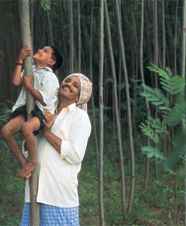
|
|
Greening
wastelands
ITC’s unique forestry programme, which
began in 1998, has helped poor tribal farmers begin a new life. Deep in the heart of
Andhra Pradesh, erstwhile wastelands of small and marginal farmers have been transformed
into dense plantations. Thanks to high-yielding, disease-resistant clonal saplings
developed by ITC at its state-of-the-art bio-technology research centre. The programme has
rejuvenated more than 19,500 hectares of wastelands by planting 66 million saplings,
creating livelihood opportunities for nearly 200,000 people. Over the next decade, 600
million saplings will convert 100,000 hectares of wastelands into plantations, with the
potential to generate income for 1.2 million people. |
|
Irrigating
drylands ITC’s
integrated watershed development programme, initiated in 2001, seeks to achieve two
critical objectives: water conservation and soil enrichment. This development initiative
is a key 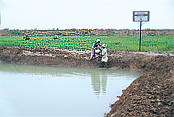 intervention to reverse moisture stress in some of the more acutely affected
drought-prone districts of the country. ITC organises farmers into water user groups that
plan and build water harvesting structures like contour bunds, check dams, percolation
tanks and farm ponds. These structures, financed by ITC, provide critical irrigation to
over 7,000 hectares of drought-prone tracts. Over the next decade, ITC aims to bring soil
and moisture conservation to 50,000 hectares of dryland under this programme. intervention to reverse moisture stress in some of the more acutely affected
drought-prone districts of the country. ITC organises farmers into water user groups that
plan and build water harvesting structures like contour bunds, check dams, percolation
tanks and farm ponds. These structures, financed by ITC, provide critical irrigation to
over 7,000 hectares of drought-prone tracts. Over the next decade, ITC aims to bring soil
and moisture conservation to 50,000 hectares of dryland under this programme. |
|
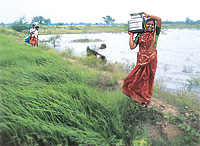 |
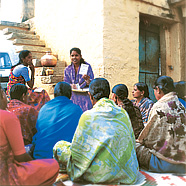 |
Creating
women entrepreneurs ITC
believes that economic empowerment of women transforms them into powerful agents of social
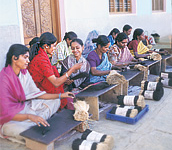 change.
Since 2001, ITC has been organising rural women into micro-credit groups, providing them
funds to build and manage a revolving development fund. These groups extend financial
support to members to set up small businesses, thereby enabling them evolve into
ntrepreneurs. What’s more, ITC also imparts training to improve their vocational
skills, thus enhancing their ability to supplement family income. Leading to better health
care, nutrition and education for their children. Over the next decade, these
micro- credit groups will have about 60,000 members, creating thousands
of women entrepreneurs. change.
Since 2001, ITC has been organising rural women into micro-credit groups, providing them
funds to build and manage a revolving development fund. These groups extend financial
support to members to set up small businesses, thereby enabling them evolve into
ntrepreneurs. What’s more, ITC also imparts training to improve their vocational
skills, thus enhancing their ability to supplement family income. Leading to better health
care, nutrition and education for their children. Over the next decade, these
micro- credit groups will have about 60,000 members, creating thousands
of women entrepreneurs. |
|
|
|

